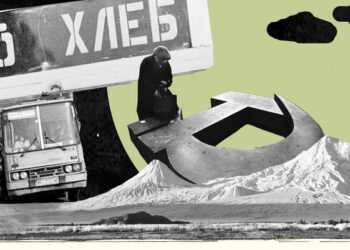
Illustration by Armine Shahbazyan.
The pullout of U.S. troops from Afghanistan, which was completed in August 2021, marked the beginning of a new period of instability for the wider region. Many experts concurred that Afghanistan under the Taliban will trigger new developments, and the center of gravity will inevitably shift to Central Asia that borders China, Russia and Iran.
To the north of Afghanistan lie the Central Asian republics that gained independence upon the collapse of the Soviet Union: Kazakhstan, Uzbekistan, Turkmenistan, Kyrgyzstan and Tajikistan. Together, the region has acquired strategic importance in economic, energy, communications and infrastructure projects that affect the whole Eurasian landmass. Kazakhstan, Kyrgyzstan and Tajikistan are members of the Collective Security Treaty Organization (CSTO). The first two are also members of the Eurasian Economic Union (EAEU). While these two organizations are dominated by Russia, nevertheless, all five countries have consistently conducted a multi-vector foreign policy aimed at ensuring their sovereignty and future economic development. In this regard, Kazakhstan and Uzbekistan are considered the heavyweights of the region, though the latter maintains a relatively low-profile foreign policy engagement.
For Russia, stability in Central Asia, part of its “near abroad”, is particularly important, especially in light of the escalated geopolitical confrontation over Ukraine. Among the five post-Soviet republics, Kazakhstan is the only one that shares a direct border with Russia. At more than 7,600 km, that border rivals the one between the United States and Canada as the second-longest in the world. Therefore, Kazakhstan offers a very important layer in Russian security policy. Any unrest in the region, and particularly in Kazakhstan, will pose fundamental security concerns for Moscow. Of particular concern is the potential for Islamic extremists to penetrate across this massive border into Russia. Therefore, as protests devolved into the breakdown of Kazakhstan’s security infrastructure in January 2022, Moscow reacted immediately and directly, blaming the involvement of outside forces.
Turkey has been actively engaging the region since the collapse of the Soviet Union. These relations culminated in the establishment of the Cooperation Council of Turkic Speaking States, also known as the Turkic Council, in Nakhichevan in 2009. In parallel with the U.S. troop withdrawal from Afghanistan, Turkey has reinforced its role in all Central Asian states, expanding and intensifying its military ties with the region. At its Istanbul summit in November 2021, the Turkic Council was officially renamed the Organization of Turkic States. It now includes Azerbaijan, Kazakhstan, Kyrgyzstan, Turkey and Uzbekistan, with Hungary and Turkmenistan participating as observer countries. The Istanbul summit adopted a Declaration, which includes 121 articles, but failed to institutionalize the joint military cooperation among the member states (the Turkish-Azerbaijani initiative of the Great Turan Army).
Turkey has also been extremely active in Afghanistan ever since the U.S. withdrawal. Together with Qatar, Ankara runs the airports in Kabul and three other cities, giving it a foothold in Afghanistan, which could in turn help it achieve broader goals. According to some analysts, Ankara wants to use Afghanistan as leverage in its relations with Europe and the United States, and entrench its foothold in the geopolitics of Central and South Asia.
In the short run, Ankara’s initiative in Afghanistan has certainly brought a change in the rhetoric used in U.S.-Turkey relations. U.S. officials have more frequently referred to Turkey as a strategic ally and invaluable partner—something the Biden administration had hitherto avoided. Nevertheless, in official discourse, Turkey’s involvement in Afghanistan has become more pronounced and emphasized in the context of the Central Asia-Turkic world dimension. Despite the general skepticism over the Turkish capacity to become a game-changer in Afghanistan and in a wider regional context, Ankara has extremely ambitious objectives that are gradually acquiring blood and bones.
Recep Tayyip Erdogan has led Turkey for almost 20 years now. Over that time, he has transformed the country away from its reputation as a “democratic and secular bastion” of the Islamic world and changed the political, military and economic profile of the country through authoritarian methods and clear-cut strategy. Positioning himself as a leader of the Muslim world, he has challenged both Israel and Saudi Arabia, gaining popularity and scoring small tactical victories at the initial stage. As instability has cropped up across the region, Turkey, with the acquiescence of the West, has used Political Islam—alongside other means—as a tool and justification to meddle beyond its borders—in Libya, Sudan, Iraq, Syria— and later provoke tensions with the Gulf states in the Middle East. For more than two decades, Ankara—together with Baku—has used the platform of the Organization of Islamic Cooperation (OIC) to ensure solidarity of the Islamic world with Azerbaijan against Armenia in the Nagorno-Karabakh conflict. With this higher profile on the regional and global stage, Erdogan and his regime have openly discussed the revival of the Ottoman Empire and adopted a “neo-Ottoman” agenda. In this context, the significance of the April 2020 conversion of the Hagia Sophia into a mosque again should not be underestimated: it is a reassertion of the imperial glory embodied in an absolute ruler (Erdogan) and a reaffirmation of a Turkey with an exclusively Islamic identity.
In this regard, there is a certain synergy between the ideologies of Erdogan and that of Al Qaeda and the Taliban movement and their effect on the global security architecture. From their viewpoint, the Islamic world has been locked in a civilizational struggle since the time of the Crusades. A common goal is to resurrect the Caliphate, representing the divine presence in the world, and ultimately elevate it to the greatness it once had. According to them, political and military pressure continues to be exercised over the Islamic world by Christianity, symbolized by the dismemberment of the Ottoman Empire. In response, they seek a mass Islamic movement that can overthrow the collaborationist governments of the Islamic world and replace them with genuinely Islamic regimes. The mujahideen, who fight for Islam, seek a regime that can serve as an example to the rest of the Islamic world and the core operating base around which to build a broader movement.
The Soviet-Afghan War of the 1980s embodied this struggle against the “godless infidel”. The ultimate failure of the Soviet invasion helped to overcome the sense that Islam’s enemies were overwhelmingly powerful, as the withdrawal of U.S. troops in 2021 has done again. A new sense that the victory of radical Islam is inevitable has helped it to attract new supporters.
The course of future developments will depend to a great degree on who takes the lead in forthcoming processes. Turkey, with its aggressive assertiveness from the Balkans and Ukraine, the Eastern Mediterranean and Libya, to the Caucasus and Central Asia, can become a decisive player in Afghanistan and this broader ideology in the coming years. Erdogan has gained the image of a genuine and devout Muslim leader who does not hesitate to confront the U.S., the EU, Israel and Russia, defending the “righteous cause” of Muslims. On several occasions, he confronted the leaders of the Islamic world, who are perceived as collaborators with the oppressors of Islam and thus hypocrites. Erdogan, as the embodiment of the new Turkey, is increasingly perceived as a symbol of hope, unification and action who can lead the Islamic renaissance. In this regard, the Turkey-Azerbaijan-Pakistan axis amplifies Ankara’s power projection, given Islamabad’s influence and connections with the Taliban movement. With its 40 million inhabitants, Afghanistan can easily become a fountain to draw from in Ankara’s notorious practice of assembling mercenary terrorist groups for deployment in various conflict areas.
From a strategic point of view, in the mid-term, Turkey’s increasing international weight is viewed as a counterbalance to the spread of Shia Iran’s influence in the Middle East, and a possible tool for regime change in that country. The Turkish leadership in the Organization of Turkic States, combined with the growing presence of the Islamist factor in Central Asia, influenced by different factions from Afghanistan, can also become a determinant for the future geopolitical climate in the region. Finally, the context of the current standoff between the collective West, on one hand, and Russia, China and Iran on the other, stipulates that Ankara may be viewed as a potential trigger for generating future geopolitical turbulence.
Kazakhstan had long been considered a bastion of political stability, but the January crisis demonstrated how quickly volatility can step in. The Russian-led CSTO intervention reshaped Kazakhstan’s politics, creating winners and losers. Though Ankara’s official stance on Moscow’s rapid reaction was rather discreet, Kazakhstan can easily become the next venue for Russian-Turkish competition.
The CSTO intervention has pacified the situation for the time being. Nevertheless, several internal and external factors will define the future outlook of Central Asia and the wider region.
Related
Russia’s Cruel Dilemma
Torn between neo-imperial ambition and the limits of its own system, Russia lives under the dual risk of American sanctions and Chinese encroachment.
Read moreThe Endless Geopolitical Struggle
Western attempts to infiltrate into the sphere of Russian influence have meant to weaken Russia and maintain constant tension. Could this result in larger clashes with more unpredictable consequences, this time between large geopolitical players?
Read moreUnblocking the South Caucasus or Blocking Armenia’s Chances?
A year after the end of the war in Artsakh, Armenia and Azerbaijan are far from a sustainable peace. Regardless of how many olive branches are gifted to the leaders of the two sides, we are once again back to a “no war, no peace” situation, writes Tatev Hayrapetyan.
Read moreRussian-Azerbaijani Relations: Tension or Intention?
Back in early October, a resident of Martakert was shot dead by Azerbaijani fire while he was driving a tractor. A Russian peacekeeper was sitting right beside him at the time. What is behind Azerbaijan’s provocations?
Read moreFrom the Arab Spring to Afghanistan: Lessons For Armenia
Back in the 2010s, Armenian policymakers were too short-sighted to assess the implications that the Arab Spring had for our own country. Does the recent American withdrawal from Afghanistan have any significance for Armenia?
Read more





